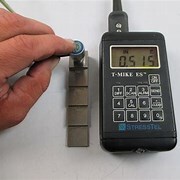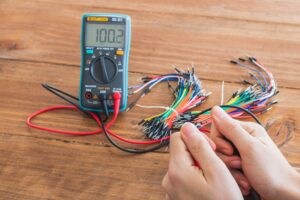ADVANCE NDT
Advanced NDT techniques are used to inspect materials and components without damaging them, allowing for more accurate and reliable testing. These methods are increasingly used in industries such as aerospace, energy, and manufacturing.
One example of an advanced NDT technique is computed tomography (CT) scanning, which uses X-rays to create detailed 3D images of the internal structure of materials and components. This allows for a more thorough inspection than traditional X-ray methods, which only provide 2D images. CT scanning is particularly useful for inspecting complex parts with intricate internal structures.
Another advanced NDT technique is phased array ultrasonic testing (PAUT), which uses multiple ultrasonic beams at different angles to inspect materials and components. This method provides highly accurate data on the location, size, and shape of defects in materials, making it useful for detecting cracks, corrosion, and other forms of damage.
Advanced NDT methods also include electromagnetic testing, such as eddy current and magnetic flux leakage testing, and optical testing, such as laser shearography and digital holography. Each method has its own strengths and weaknesses, and the choice of method depends on the type of material being tested, the size and shape of the component, and the specific requirements of the inspection.
In conclusion, advanced NDT techniques are increasingly used in industries to provide more accurate and reliable inspection data. With methods such as CT scanning and phased array ultrasonic testing, manufacturers can detect defects in materials and components without damaging them. By choosing the appropriate NDT method, manufacturers can ensure the quality and safety of their products while also minimizing the risk of defects or failures.
2.1 AUT (Automated Ultrasonic Test)

AUT is a non-destructive testing method that uses ultrasonic waves to detect flaws and defects in materials and structures. It is commonly used in the oil and gas industry for inspecting pipelines and welds.
AUT uses automated equipment, such as robots or crawlers, to perform inspections in a more efficient and accurate manner than manual testing. The equipment can be programmed to move along the pipeline or weld, sending ultrasonic waves through the material and collecting data on any flaws or defects.
One of the main advantages of AUT is its ability to detect flaws that may be missed by manual testing methods. The automated equipment can perform inspections in difficult-to-reach areas and can collect more data than a human inspector in a shorter amount of time. This allows for more thorough inspections and reduces the risk of defects going undetected.
Another advantage of AUT is its ability to provide detailed data on the location, size, and shape of defects in materials and structures. This data can be analyzed using software to create 3D images of the flaws, allowing for more accurate assessments of their severity and potential impact on the material or structure.
AUT is also a safer testing method than manual testing, as it reduces the risk of injury to human inspectors who may need to work in hazardous or difficult-to-reach areas.
In conclusion, Automated Ultrasonic Testing is an effective and efficient method of non-destructive testing that allows for more accurate and thorough inspections. With its ability to detect flaws that may be missed by manual testing, provide detailed data on the location and shape of defects, and improve safety, AUT has become an increasingly important tool in industries such as oil and gas, aerospace, and manufacturing.
2.2 PAUT (Phase array ultrasonic Test
PAUT is a non-destructive testing method that uses ultrasonic waves to inspect materials and structures for flaws and defects. It is a highly accurate and reliable testing method that is widely used in industries such as aerospace, automotive, and manufacturing.
PAUT uses a specialized probe that contains multiple ultrasonic elements that can be controlled individually. These elements can be activated and focused in different directions and at different angles, allowing for a more thorough inspection of the material or structure being tested. This method provides highly detailed data on the location, size, and shape of flaws and defects, making it ideal for detecting cracks, corrosion, and other forms of damage.
One of the main advantages of PAUT is its ability to provide faster and more accurate inspection results than traditional testing methods. PAUT can perform inspections more quickly than manual testing, and it can detect smaller flaws and defects that may be missed by other methods.
Another advantage of PAUT is its ability to perform inspections on complex geometries and hard-to-reach areas. The focused beams of ultrasonic waves can penetrate deep into the material being tested, allowing for more accurate and thorough inspections.
PAUT is also a safer testing method than traditional methods, as it reduces the need for human inspectors to work in hazardous or difficult-to-reach areas.
In conclusion, phased array ultrasonic testing is a highly accurate and reliable non-destructive testing method that is widely used in industries to detect flaws and defects in materials and structures. With its ability to provide faster and more accurate inspection results, inspect complex geometries, and reduce the need for human inspectors to work in hazardous or difficult-to-reach areas, PAUT has become an increasingly important tool in industries such as aerospace, automotive, and manufacturing.
2.3 LRUT (Long range ultrasonic Test)
LRUT is a non-destructive testing method that uses ultrasonic waves to detect flaws and defects in pipes and other structures over long distances. It is commonly used in the oil and gas industry to inspect pipelines.
LRUT uses low-frequency ultrasonic waves to send signals through the material being tested. These signals are then reflected back to the transmitter and receiver, providing data on the thickness and integrity of the material. The method is particularly useful for inspecting pipes and other structures that are difficult or impossible to access using other testing methods.
One of the main advantages of LRUT is its ability to detect flaws and defects over long distances. The low-frequency ultrasonic waves can penetrate deep into the material being tested, allowing for inspections to be performed over hundreds of meters of pipe from a single location. This reduces the need for human inspectors to access difficult-to-reach areas, improving safety and reducing inspection times.
Another advantage of LRUT is its ability to inspect pipes and structures through coatings, insulation, and other materials. This allows for more accurate and thorough inspections, as the signals can penetrate through the outer layers of the material and detect flaws and defects in the underlying structure.
LRUT is also a cost-effective testing method, as it reduces the need for costly excavation or dismantling of the structure being inspected. This can save time and money, while also reducing the environmental impact of inspections.
In conclusion, Long Range Ultrasonic Testing is a non-destructive testing method that uses low-frequency ultrasonic waves to inspect pipes and other structures over long distances. With its ability to detect flaws and defects through coatings and insulation, reduce the need for human inspectors to access difficult-to-reach areas, and save time and money on inspections, LRUT has become an important tool in the oil and gas industry and other industries that rely on pipes and structures for their operations.
2.3 ECT (Eddy Current Test)

ECT is a non-destructive testing method that uses electromagnetic induction to detect surface and near-surface flaws in conductive materials. It is commonly used in industries such as aerospace, automotive, and manufacturing to inspect metal components for cracks, corrosion, and other forms of damage.
ECT works by inducing an alternating current in a coil of wire, which creates a magnetic field around the coil. When the coil is brought near a conductive material, eddy currents are induced in the material. These eddy currents create their own magnetic field, which interacts with the coil’s magnetic field. This interaction produces a signal that is detected by the coil, providing information on the material’s conductivity, thickness, and any flaws or defects present.
One of the main advantages of ECT is its ability to detect surface and near-surface flaws without requiring physical contact with the material being tested. This makes it a non-invasive testing method that is ideal for inspecting delicate or hard-to-reach components. ECT can detect small cracks and corrosion that may be missed by other testing methods, allowing for early detection of potential issues and preventative maintenance.
Another advantage of ECT is its ability to inspect a variety of materials, including metals, alloys, and some non-conductive materials such as ceramics and composites. It can also be used to measure the thickness of thin materials such as foils and coatings, making it a versatile testing method.
ECT is a fast and cost-effective testing method, as it can be performed quickly and without the need for special preparation or cleanup. This makes it ideal for use in production lines and other industrial settings where time and efficiency are important factors.
In conclusion, eddy current testing is a non-destructive testing method that uses electromagnetic induction to detect surface and near-surface flaws in conductive materials. With its ability to detect small cracks and corrosion, inspect a variety of materials, and be performed quickly and non-invasively, ECT has become an important tool in industries such as aerospace, automotive, and manufacturing.
2.4 MFL (magnetic floor leakage Test)
MFL is a non-destructive testing method that is commonly used to inspect pipelines and other structures for corrosion and other forms of damage.
MFL works by using a magnet to magnetize the steel or iron material being tested. A magnetic field is then induced into the material, causing the magnetic field lines to flow smoothly through the material. When the material is not uniform, such as when there is a defect or corrosion, the magnetic field lines will be disrupted and create a leakage field. A sensor is then used to detect these areas of leakage, which can indicate the location and extent of damage.
One of the main advantages of MFL is its ability to detect corrosion and other types of damage to the structure being tested, even when it is located beneath coatings and other materials. This makes it a valuable tool for inspecting pipelines and other structures that are difficult to access or inspect using other methods.
Another advantage of MFL is its speed and efficiency. The method can be used to inspect long stretches of pipeline quickly and accurately, reducing the need for human inspectors to access difficult-to-reach areas. This can save time and money on inspections while also improving safety.
MFL is also a cost-effective testing method, as it can detect flaws and defects that may be missed by other methods, reducing the risk of catastrophic failures and the associated costs of repairs and downtime.
In conclusion, Magnetic Flux Leakage Testing is a non-destructive testing method that uses a magnet to detect corrosion and other forms of damage in pipelines and other structures. With its ability to detect damage beneath coatings and other materials, speed and efficiency, and cost-effectiveness, MFL has become an important tool in the oil and gas industry and other industries that rely on pipelines and other structures for their operations.
